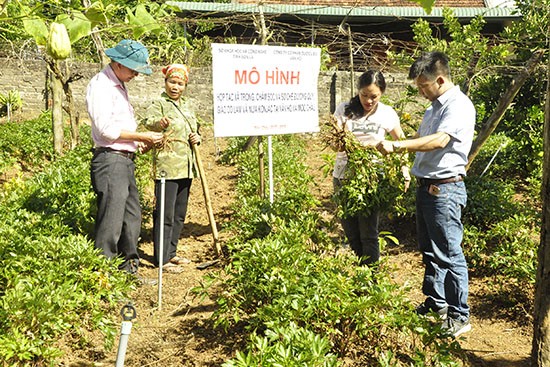(VOVWORLD) - Son La province has a climate and soil suitable for medicinal plants. But productivity is low – too low to meet market demand. To make medicinal herbs an economic spearhead, Son La has planted new varieties, applied new technology, improved management of product quality and food safety, and contracted with businesses to buy farm products through cooperatives.
 An ashweed growing model in Son La province. (Photo: baosonla.org.vn) An ashweed growing model in Son La province. (Photo: baosonla.org.vn) |
Son La province has a relatively large forestry sector, more than 540,000 hectares, and has been helping local people develop an economy under the forest canopy, especially medicinal plants. Several medicinal herb growing models have been tried and have proven highly profitable.
Son La has more than 560 species of medicinal plants, many of which are quite valuable like cat canh (platycodon), dinh lang (Polyscias fruticose), ba kich (codonopsis), and ashweed. Medicinal plants are mainly grown in Bac Yen, Moc Chau, and Van Ho district.
To make medicinal plant cultivation more sustainable and profitable, in 2017 all 92 Mong households in Pa Cu Sang A hamlet in Bac Yen district began to grow medicinal plants.
The hamlet’s economy used to depend on 48 hectares of terraced rice fields, cattle, and management of 1,000 hectares of watershed forests. Their lives were dificult, and they were forced to expand their farms into the forests.
A number of Pa Cu Sang A villagers planted cardamom under the forest canopy on the early 2000s and the cardamom has grown well. Now almost every local household grows cardamom and output reached nearly 20 tons of fresh fruit in 2018.
Giang A Do, the hamlet’s head, said, “Growing cardamom under the forest canopy can boost a family’s economy while protecting the forest. Every day we come to the forest to tend the trees, thereby reducing forest destruction by loggers.”
To expand the cultivation area of medicinal plants, Son La has promulgated mechanisms and policies to attract investors, linked farmers, business people, scientists, and the State, and conducted planning that takes into account the strengths of each climate sub-region.
Nguyen Duc Thinh, Deputy Chairman of the Bac Yen district People’s Committee, said, “The district has directed communes to set up cooperatives to buy all farm products and find outlets. In addition, we have created policies to encourage pharmaceutical businesses to invest in the area.”
Son La’s farm land for medicinal plants is 13,000 ha out of 540,000 ha of forest land, with an annual output of 20,000 tons.
“We have coordinated with functional agencies to build brands for several medicinal plants, and conducted promotional programs to introduce Son La's medicinal plants to domestic markets and foreign partners,” said Cam Thi Phong, Deputy Director of the provincial Department of Agriculture and Rural Development.
Son La is encouraging businesses to work with local cooperatives to build raw material areas and processing factories. It has set a target of 100,000 ha of medicinal plants grown under the forest canopy by 2025.